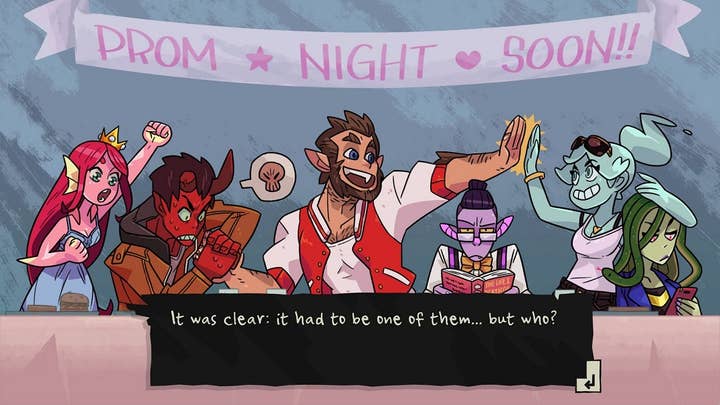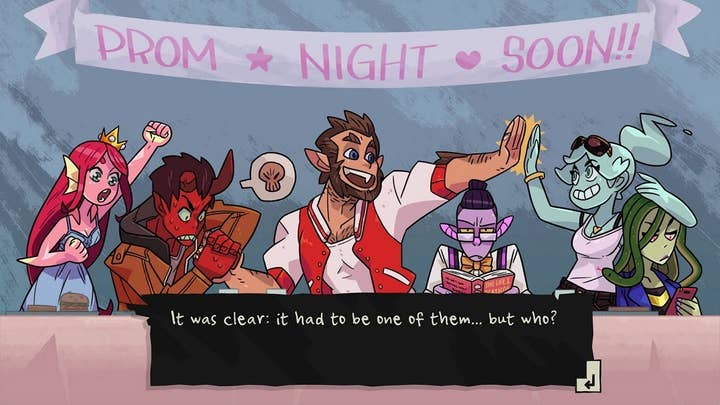Developing for fandom at every level
Beautiful Glitch creative director Julián Quijano explains how Monster Prom was designed with fan consumption in mind
The games industry is packed with developer success stories driven by a fervent fanbase, but devotion of that sort isn't likely to happen without a little help.
In a GDC Showcase presentation this week, Beautiful Glitch creative director Julián Quijano shared a few strategies the Barcelona-based studio used in the creation of its 2018 supernatural dating sim Monster Prom.
Quijano opened the talk with some evidence that Monster Prom does in fact have a sizable group of fans. He noted that the game's Second Term expansion pack sold more than 250,000 copies, making for a conversion rate of about 50% of the original game's purchasers. On top of that, the 2019 Kickstarter campaign for a sequel to the game raised more than $600,000, with an average backer pledge of about $60, five times the amount that would get backers a copy of the game.
As for how Beautiful Glitch cultivated that sort of support, Quijano employed a cake metaphor, saying fandom develops in three separate layers.
The first layer is an enticing first bite, a first impression that gives people a reason to care about the game. He likened the second layer to "achieving a smooth transition from bite to binge," creating different levels of the fiction that invite the audience to explore the property a little deeper.
The final level is "binging from the heart," the point at which people connect to your work on deeper levels.
"People on the deep levels aren't just spending a lot of time and that's it on your fiction," Quijano said. "They're also starting to connect in deeper levels of values, identity, emotions... So they truly connect with your fiction."
This can manifest as people consuming every bit of available content related to the game, socializing within the fandom on Discord channels, or even using the game as a lens for their own creative output, be it through fan art, fan fiction, or cosplay.
While Quijano said he came up with numerous techniques to bolster the fandom, he settled on going into some depth on one tactic for each of the three levels.
Get that first bite
"When you're creating something and you want to market it to an audience, it's very important to frame the perception of that audience," Quijano said.
He referenced a story of an old marketing strategy where a soda company is surveying people about their tastes. The company wouldn't ask people, "Do you drink soda?" as a yes or no question, because half of those responses are basically conversation-enders from the company's point-of-view.
Instead, the company might ask people if they prefer sweet strawberry soda, exotic papaya soda, or supercool blue soda. That phrasing assumes that the respondent wants soda; now it's just up to them to figure out which kind of soda they're in the mood for.
"It helps you to make your audience go past that first wall of disinterest and actually check into what the story's about," Quijano said.
As non-soda examples, he pointed to Harry Potter, in which the wizardry school of Hogwarts sorts students into four different houses, each of which is known for certain traits. Even people who never read a page or watched a minute of Harry Potter may have looked up what the deal was with Gryffindor, Hufflepuff, Ravenclaw, and Slytherin, and perhaps pondered which house they would be sorted into.
"Human beings tend to organize information in categories and groups because it makes the information more easily digestible," Quijano said. "So these create shortcuts and make easier to understand complex structures like the fiction you're trying to sell."
For an example of how that could be used in games, Monster Prom has players choose between six main potential love interests that are familiar monster types, fit into character tropes, and are (mostly) designed with distinct color schemes. So players are pretty quickly pondering if a red demon bad boy is more appealing to them than a green gorgon mean girl or a purple vampire hipster.

Quijano said that initial choice can be made powerful with the addition of what he called "sexy themes," or universal and recognizable categories and symbols, like elements, zodiac signs, or planets. As a Capricorn himself, Quijano said he often checks to see which characters in a zodiac-themed game are also Capricorns.
"When you create these categories or this first big choice, it's good if the options have visual distinction and a clarity of tropes," Quijano said. "You need to make the choices very distinct from each other so people feel even more pushed subconsciously into choosing one that speaks to them. Because in the end, it's a lot about out tendency to seek a sense of belonging, even if it means belonging to one group, house, category, or character in a fiction."
The power of the relatable
Quijano briefly noted a number of tactics to take the audience from their first bite to binging fandom. Some, like twisting tropes in unexpected ways, are closer to the bite end of the spectrum, while the one he discussed in depth -- the power of the relatable -- are closer to the binge.
"There's a value in mixing the fantastic and the mundane"
He mentioned the opening scene Reservoir Dogs, where the film's crew of killers and criminals have menial conversation at a restaurant, discussing things like proper tipping etiquette. The characters on screen may exist in a world of shoot-outs, intrigue, and betrayal, but conversations like that can give the audience something to connect with.
"There's a power in making stuff relatable," Quijano said, adding, "It grounds your fiction in what can be recognized and seen as something close to us. There's a value in mixing the fantastic and the mundane."
Monster Prom is a fairly straight-forward application of this point, combining monsters -- which Quijano said were there "for no good reason other than monsters are cool and they're popular" -- with a high school setting that people could more readily relate to. The result is fiction that lends itself to people projecting themselves into the story.
"You want your fiction to be fantastic enough that you want to imagine yourself in there, but mundane enough so you can imagine yourself in there," Quijano said, suggesting a brainstorming exercise of imagining a mundane job or setting and combining it with a more fantastic element, like a lawfirm with superhero clients or a gray, personality-free office environment where the workers are creating actual new worlds.
Voice and values
Once players have reached the third layer of the cake, they need depth to keep them around. Quijano acknowledged that basing characters on tropes may have worked for giving players something instantly appealing, but those tropes need to be disrupted in places and the characters need to be fleshed out and made to feel real.
"I think there's a richness in listening to stories that are far from ours..."
That means spending time finding themes for the cast, considering their upbringing and back stories. Specific details are particularly important, Quijano said, as they can give the audience something to build a rapport with and give the characters additional texture.
"Let's not just make them one way, but try to understand how they came to be that way," Quijano said.
He added that characters should also have values, "specific ways in which they understand the world that surrounds them."
"The main goal is to get a variety of voices that feel real and unique and different that help people to project and to identify with," Quijano said.
He also stressed that there's no risk in telling diverse stories, as pretty much any individual's specific story will have a touch of the universal in it.
"I think there's a richness in listening to stories that are far from ours, and learning from experiences that diverge from ours," Quijano said, adding that if people can connect with stories about space pirate, they probably can connect with all kinds of stories.
"The main idea here is you need to understand there's value in having not just an audience, but a fandom," Quijano concluded. "So build your creations with the concept of fan consumption in mind, making them multilayered, and caring for every layer in it."









